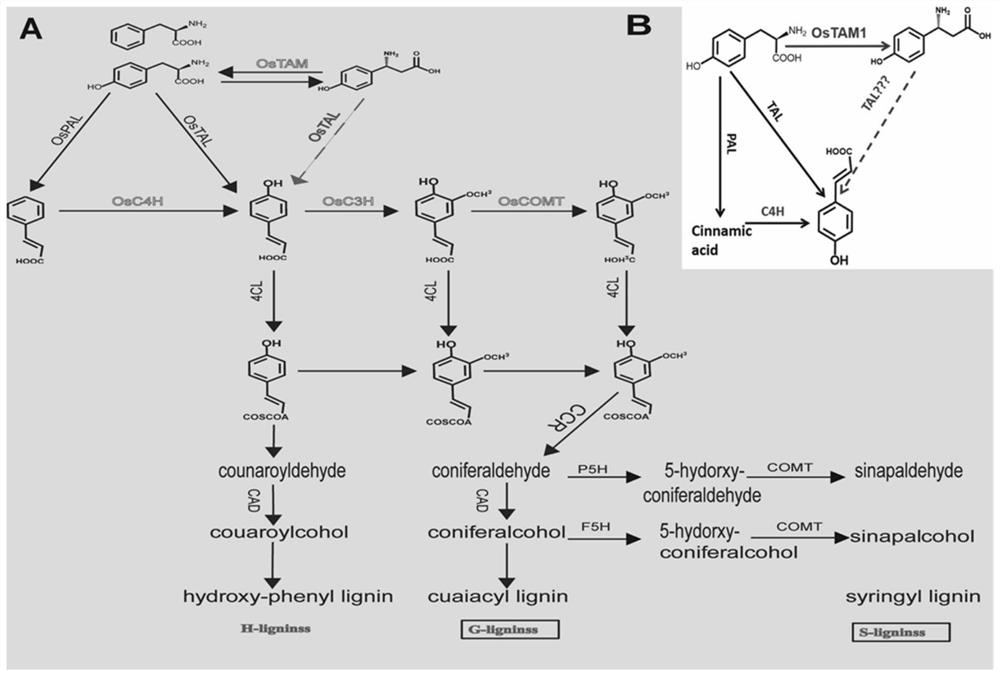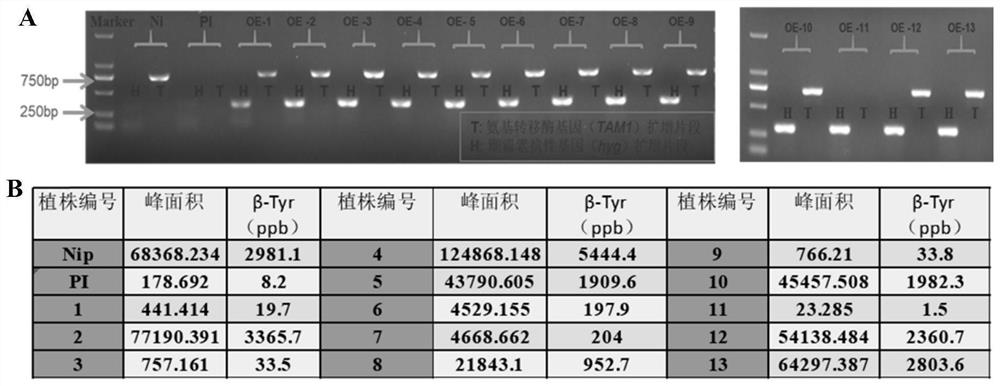Application of rice ostam1 gene in regulation of plant leaf angle
A plant leaf and plant leaf technology is applied in the application field of rice OsTAM1 gene in regulating the angle of plant leaves, which can solve the problem of unclear molecular mechanism, improve catalytic activity, change lignin metabolic flow, and increase cell density. Effect
- Summary
- Abstract
- Description
- Claims
- Application Information
AI Technical Summary
Problems solved by technology
Method used
Image
Examples
Embodiment 1
[0054] Example 1 Construction of plants overexpressing OsTAM1 gene
[0055] 1.1 Overexpression of OsTAM1 gene
[0056] Take the rice leaves of the rice variety Nipponbare (Ni) at the tillering stage, use Takara's RNA extraction reagent and extract total RNA, and use Takara's reverse transcription kit to reverse-transcribe the total RNA into cDNA. Enter the gene accession number (LOC_Os12g33610) of OsTAM1 in rice.plantbiology.msu.edu / ) to obtain the CDs sequence (SEQ ID NO.1) of the gene, and design the synthetic primer pair (33610F: 5′- ATGAGGCTTGCCAAGGA GCA-3'; 33610R: 5'-GCAGCGCTAGCAGATCGTC-3'), after the cDNA of OsTAM gene was obtained by PCR amplification, the target fragment was ligated into pMDC32 vector (pMDC32 vector was purchased from Boyuan Biotechnology Co., Ltd.) obtained), after confirming that the vector was successfully constructed by PCR amplification and sequencing, the constructed overexpression vector OsTAM1-pMDC was introduced into Agrobacterium EHA105 com...
Embodiment 2
[0071] Example 2 The effect of β-Tyr on leaf erection in rice seedling stage
[0072] 2.1 The effect of exogenous addition of β-Tyr on leaf erection in rice seedling stage
[0073] 2.1.1 Take PI (without β-Tyr) seeds for germination in a 30°C incubator, and then sow them in a 96-well plate, such as image 3 In the black box shown in A, a total of 7 plates were sown. After three days of incubation with water, it was replaced with a basic rice culture medium, and β-Tyr (ie 3-amino-3-(4-hydroxyphenyl) was added to the culture medium correspondingly. Propionic acid, molecular formula C 9 H 11 NO 3 ; CAS No.: 6049-54-3) and α-Tyr (2-amino-3-p-hydroxyphenylpropionic acid), so that the final concentrations were 0 μM, 0.05 μM, 0.1 μM, 0.5 μM, of which 0 μM was the control Group (CK), the rest are treatment groups, after culturing for 10 days, the effects of different treatments on leaf angle were observed and the percentage of leaf bending plants on the 10th day was counted. is c...
Embodiment 3
[0087] Example 3 The effect of β-Tyr on the included angle of the flag leaves in the flowering stage of rice
[0088] 3.1 Continue to cultivate the control PI and overexpressed plants (OE-1, OE-2, OE-3) of 2.2 for half a month, and then transplant them to the field for planting, and pay attention to water, fertilizer and pest management during this period. The phenotype of each line was photographed at the flowering stage of rice, and the results were as follows Image 6 and measured the leaf opening angle of rice, using a protractor to measure the sword leaf inclination angle and leaf opening angle of rice (the included angle of rice leaf refers to image 3 C). Three lines of the control and overexpression plants were taken respectively, and each line was replicated 15 times, and the leaf angle and the angle between the leaves of the flag leaves of the rice at the tillering stage were measured for each plant. The statistical results are as follows: Figure 7 A and 7B are sh...
PUM
 Login to View More
Login to View More Abstract
Description
Claims
Application Information
 Login to View More
Login to View More - R&D
- Intellectual Property
- Life Sciences
- Materials
- Tech Scout
- Unparalleled Data Quality
- Higher Quality Content
- 60% Fewer Hallucinations
Browse by: Latest US Patents, China's latest patents, Technical Efficacy Thesaurus, Application Domain, Technology Topic, Popular Technical Reports.
© 2025 PatSnap. All rights reserved.Legal|Privacy policy|Modern Slavery Act Transparency Statement|Sitemap|About US| Contact US: help@patsnap.com



